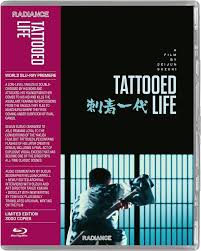Tetsu (Hideki Takahashi) and Kenji (Kotobuki Hananamoto) are brothers, very different in temperament but bonded by blood. Tetsu is a hardened yakuza hitman who finds himself on the other end of a Yakuza altercation, but is saved by more sensitive and artistic Kenji, leaving Tetsu’s attacker dead. They are both forced to skip town for fear of retaliation from the yakuza. With limited funds, they wind up in a small seaside town where they get a job as construction workers to save up enough money to get out of the country. While there, they both find themselves falling in love with the wrong women, Tetsu with the boss’s sister and Kenji with the boss’s wife. The whole time they are also forced to contend with avoiding the attention of the local police as well as the local yakuza gang. But they can’t run from their fates forever, leading to an explosive climax.
According to Tom Vick’s excellent essay on the film included in the physical booklet, Tattooed Life marks a kind of tipping point for director Seijun Suzuki, from his earlier days at Nikkatsu as a director-for-hire churning out straightforward crime pictures to his last couple of years at the studio which found him boldly experimenting with style and form, ultimately culminating in his firing from the studio after the more experimental Tokyo Drifter and Branded to Kill. As such, the film has touches of this future experimentation here and there while also telling what is primarily a fairly standard yakuza narrative about how one cannot run from one’s past forever. Suzuki’s future path is most clearly seen in the beautifully shot, psychedelic final fight sequence, saturated with a varied bright color palette with a variety of creative ways of shooting the scene, including even angled from underneath the floor pointing upward. The film isn’t all flash though. There are small touches here and there of Suzuki’s attention to detail. We see Tetsu adjusting his clothing, always looking mildly uncomfortable or self-conscious. He’s afraid of someone noticing his tattoos, a symbol of his past with the yakuza. Takahashi plays Tetsu with a complexity that this kind of role normally isn’t written with.
The digital transfer supplied to Radiance by Nikkatsu looks quite nice in general. The grain never feels overwhelming and the color saturation seems very well balanced between the more naturalistic hues of the pastoral character scenes contrasted with the more vibrant blues and reds of the more kinetic sequences like the climax. The uncompressed mono audio track sounds nice and clear with no noticeable distortion. Once again Radiance has provided a meaningful slate of extras to accompany the film. First is an audio commentary by Seijun Suzuki biographer William Carroll which has lots of useful information about Suzuki and where the film is placed within his overall oeuvre. Also included are interviews with Seijun Suzuki as well as art director of Tattooed Life Takeo Kimura and a physical booklet including the aforementioned essay on the film by Tom Vick as well as a mixed review of the film by Tetsuya Fukasawa, translated by Tom Mes, originally printed in the November 1965 issue of Kinema Junpo. It’s interesting to see how Suzuki’s more forward-thinking experimental flourishes weren’t received well at the time.
Through a combination of nuanced acting choices and Seijun Suzuki’s exasperation of the studio system which fueled his desire to break free and do something new and interesting, Tattooed Life is a great transitional film that is essential viewing for fans of Suzuki looking to chart the arc of his career, and Radiance has delivered the film in a very nice package worthy of picking up.

